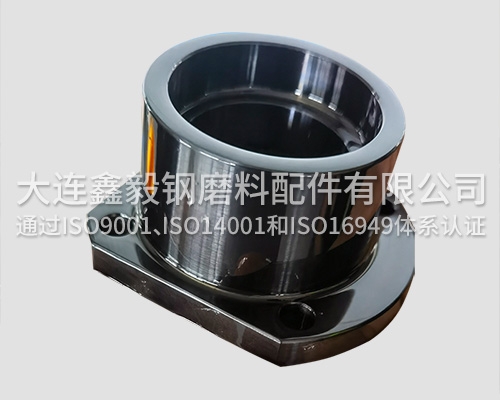Welcome to the official website of Dalian Xinyi steel abrasive parts Co., Ltd!
Dalian Xinyi steel abrasive parts Co., Ltd
Contact: Manager Zhang
Telephone: 0411-39630390
0411-39569620
mobile phone:13795133932
website:en.dlxyg.com.cn
Address: No. 10, Shengsheng Second Road, Dalian Economic and Technological Development Zone
Office worker: Quanshui P3, Ganjingzi District, Dalian
Generally speaking, there are several methods for blackening surface treatment, including chemical treatment, physical treatment, and laser treatment. Among them, chemical treatment is a common method that can achieve surface blackening by immersing materials in specific solutions or coating them with specific chemical reagents, causing chemical reactions on the surface of the materials to form a black oxide film or a physical structure similar to an oxide film.
According to the selected blackening treatment method (such as alkaline oxidation, acidic oxidation, or electrolytic oxidation), place the pre treated workpiece into the corresponding blackening treatment solution for treatment. During the processing, it is necessary to strictly control the temperature, concentration, and processing time of the solution to ensure that the quality of the generated oxide film meets the requirements.
How to conduct quality inspection on workpieces with blackened surface treatment in Dalian?
1、 Appearance inspection
Color and hue
Under normal circumstances, the surface color of the workpiece after blackening treatment should be uniform black or black blue. During inspection, it should be carried out under natural light or standard light sources to ensure consistent color on the entire surface of the workpiece. If the color is uneven, it may be due to the improper position of the workpiece in the solution during the blackening process, resulting in different degrees of contact with the oxidant; Or there may be differences in solution temperature and concentration in different regions.
For example, if the local color is too light, it may be due to insufficient reaction of the area in the blackening solution, which may be caused by uneven stirring of the solution, resulting in insufficient supply of oxidant in this area. Areas with excessively dark colors may be caused by excessive local temperature or prolonged processing time, leading to excessive oxidation reactions.
Surface integrity
Carefully inspect the surface of the workpiece for defects such as spots, dents, peeling, cracks, etc. These defects will seriously affect the protective performance and aesthetics of the oxide film. Spots and pockmarks may be caused by incomplete surface pretreatment of the workpiece, residual impurities affecting the oxidation reaction during the blackening process, or contamination of the blackening solution.
The peeling off of oxide film is usually due to poor adhesion between the oxide film and the metal substrate, which may be caused by excessive acid washing, damaging the microstructure of the metal surface and making it difficult for the oxide film to adhere; Or improper post-processing after blackening treatment (such as cleaning, filling, oil immersion, etc.) can cause damage to the oxide film. The appearance of cracks may be due to excessive stress on the oxide film during its formation, such as internal stress caused by rapid cooling or uneven thickness of the oxide film.
2、 Thickness detection
Testing tools and methods
Magnetic thickness gauge: suitable for detecting the thickness of non-magnetic coatings (such as black oxide films) on magnetic substrates (such as steel). The principle is based on the magnetic attraction between the probe and the magnetic substrate. When the probe approaches the surface of the workpiece, the thickness of the oxide film will affect the magnitude of the magnetic attraction. The sensor of the instrument converts this change into an electrical signal, which displays the thickness of the oxide film.
Eddy current thickness gauge: mainly used to detect the thickness of non-conductive coatings on conductive substrates. When the probe of the thickness gauge approaches the surface of the workpiece, an alternating magnetic field is generated, forming eddy currents on the surface of the conductive substrate. The variation in the thickness of the oxide film will affect the magnitude of eddy currents, allowing the instrument to measure the thickness of the oxide film. This method is also effective for detecting black oxide films on non-magnetic metals such as aluminum alloys.
Thickness standard judgment
The thickness of the blackened oxide film is generally between 1-10 μ m, but the specific thickness requirements may vary depending on factors such as the working environment and functional requirements of the workpiece. If the oxide film is too thin, its anti-corrosion ability will be greatly reduced, and it will not be able to effectively isolate the metal substrate from the external environment. For example, in humid or highly corrosive environments, overly thin oxide films may quickly be corroded and penetrated.
On the contrary, if the oxide film is too thick, it may increase its brittleness and easily peel off when subjected to external impact or thermal stress. Moreover, excessive oxide film may affect the dimensional accuracy of the workpiece, which is unacceptable for some precision workpieces that require high dimensional accuracy.
3、 Adhesion test
Grid method
This is a simple and commonly used testing method. Use a specialized grid cutting tool to grid the surface of the blackened workpiece, usually with a spacing of 1-2mm, forming small squares. When cutting, ensure that the tool cuts through the oxide film to the metal substrate. Then, use adhesive tape (such as 3M tape) to firmly stick it to the grid area, quickly peel off the tape, and observe the detachment of the oxide film inside the grid.
If the number of detached squares does not exceed a certain proportion (for example, generally not exceeding 5%), it is considered that the adhesion of the oxide film is qualified. This method can intuitively evaluate the bonding strength between the oxide film and the metal substrate.
Bending method
For some workpieces with allowed shapes, the bending method can be used to test adhesion. Bend the workpiece at a certain angle (such as 90 ° or 180 °) and observe whether there is peeling or cracking of the oxide film at the bent part. This method simulates the deformation that the workpiece may experience during actual use, and can effectively test the adhesion of the oxide film under mechanical stress.
The main purpose of blackening surface treatment is to increase the corrosion resistance, wear resistance, and high temperature resistance of the material surface, in order to extend the service life of the material and improve its performance stability. At the same time, by blackening the surface treatment, the appearance quality and visual effect of the material can be improved, making it more in line with modern and fashionable design requirements.
Blackening treatment mainly involves the formation of a black oxide film on the metal surface through chemical oxidation reactions. For steel materials, they are usually treated in alkaline solutions containing oxidants such as sodium hydroxide, sodium nitrite, etc. Under certain temperature and time conditions, iron atoms on the surface of steel react with oxidants in the solution to generate various iron oxides, mainly iron trioxide(Fe₃O₄).

![]()
Office address: P3 Quanshui District, Ganjingzi District, Dalian
Factory address: No. 10, Shengsheng Second Road, Dalian Economic and Technological Development Zone
Copyright © http://en.dlxyg.com.cn/ 大连鑫毅钢磨料配件有限公司 Specializing inDalian sandblasting,Dalian shot blasting,Dalian blackened surface treatment,Welcome to inquire!
辽ICP备18004327号 Powered by Clouds platform Technical Support:Joint enterprise Era
 | Wechat scan Pay attention to our timely information |